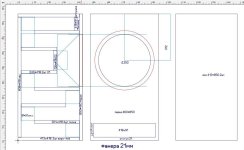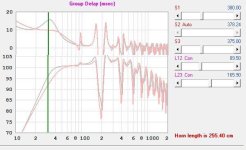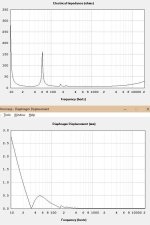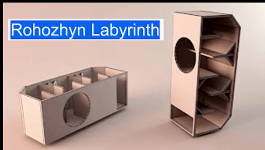Hello, I have these handmade speakers, what kind of cabinet do you think they can be used in? They will play up to 500 Hz
Attachments
-
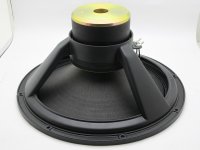 Изображение WhatsApp 2024-03-17 в 13.28.40_4c36a42e.jpg212.4 KB · Views: 70
Изображение WhatsApp 2024-03-17 в 13.28.40_4c36a42e.jpg212.4 KB · Views: 70 -
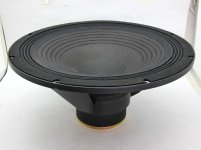 Изображение WhatsApp 2024-03-17 в 13.28.40_7076bde7.jpg244.3 KB · Views: 57
Изображение WhatsApp 2024-03-17 в 13.28.40_7076bde7.jpg244.3 KB · Views: 57 -
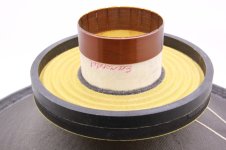 Изображение WhatsApp 2024-03-17 в 13.28.40_998683b0.jpg268 KB · Views: 65
Изображение WhatsApp 2024-03-17 в 13.28.40_998683b0.jpg268 KB · Views: 65 -
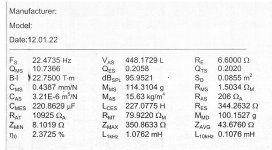 Изображение WhatsApp 2024-03-17 в 13.30.17_79f758f5.jpg191.8 KB · Views: 62
Изображение WhatsApp 2024-03-17 в 13.30.17_79f758f5.jpg191.8 KB · Views: 62
FYI/FWIWAwefully low Q. Not really ideal for a TL.
https://rogozhin-labyrinth.blogspot.com/2014/02/rus.htmlУжасно низкий Q. Не совсем идеально для TL.
Max Flat герметичный: 40 литров F6 60 Гц, F10 середины 50-х годов.
Номинальный рефлекс: 60 литров, 43 Гц, F6 в середине 50-х, F10 в высоких 40-х.
Вам нужно добавить некоторое демпфирование в модель HornResp
Perhaps you don’t understand, I’m making a non-standard Labyrinth
Thanx freddie, google was choking.
A labyrinth is really an overlong pipe damped until aperiodic, not quite what is defined in the first paragraph. And the line does not need to be constant.
But in recent times the term has been used as a descriptor for some quarter wave lines. Scott and i for iatnce with the Baby Labs: https://www.diyaudio.com/community/threads/woden-design-3-box-designs-babylabs-more.247904/
The folding in the box linked is not very good, the line definition is not all that effective. When modeled in hornREsp one would have to add all the (largish) expansions in the line at each folding. The deflectors are lkikely counter productive. A much more effective and less resource intense folding can be devised.
If one sacrifices damoing you need to live with ripple,m why a front terminus is not the best idea.
dave
A labyrinth is really an overlong pipe damped until aperiodic, not quite what is defined in the first paragraph. And the line does not need to be constant.
But in recent times the term has been used as a descriptor for some quarter wave lines. Scott and i for iatnce with the Baby Labs: https://www.diyaudio.com/community/threads/woden-design-3-box-designs-babylabs-more.247904/
The folding in the box linked is not very good, the line definition is not all that effective. When modeled in hornREsp one would have to add all the (largish) expansions in the line at each folding. The deflectors are lkikely counter productive. A much more effective and less resource intense folding can be devised.
If one sacrifices damoing you need to live with ripple,m why a front terminus is not the best idea.
dave
The original 1937 article by Onkley that defines a labyrinth: http://www.t-linespeakers.org/download/Onley-acoustic-labyrinth.pdf
dave
dave
Basically as with many designs and theory.
It looks cool.
But ends up being a bass reflex
with a port to large and too long.
So more magic math is needed to
basically figure out the " offset"
Which is whatever is needed to get a normal
reflex volume. Then magical " tapers"
and absorption to make less resonance
from the port that is too long.
Load you TS parameters into
any modeling program.
Use a normal everyday QB3
reflex alignment. And your done.
If your using rounds ports with no shared walls
or some sort of magic tunnel thing with shared walls.
Then end correction needs to be applied. For shared
walls. If the tunnel thing is too long, then add the usual
absorption material
It looks cool.
But ends up being a bass reflex
with a port to large and too long.
So more magic math is needed to
basically figure out the " offset"
Which is whatever is needed to get a normal
reflex volume. Then magical " tapers"
and absorption to make less resonance
from the port that is too long.
Load you TS parameters into
any modeling program.
Use a normal everyday QB3
reflex alignment. And your done.
If your using rounds ports with no shared walls
or some sort of magic tunnel thing with shared walls.
Then end correction needs to be applied. For shared
walls. If the tunnel thing is too long, then add the usual
absorption material
I once compared the same speaker in three different designs: a closed box bass reflector and Rogozhin’s Labyrinth, This design has huge advantages:Складывание в коробке не очень хорошее. , определение линии не так уж и эффективно. При моделировании в HornREsp пришлось бы добавлять все (большие) расширения линии при каждом сгибе. Дефлекторы, скорее всего, контрпродуктивны. Можно придумать гораздо более эффективное и менее ресурсоёмкое складывание.
Если жертвовать дамоингом, то придется жить с пульсацией, поэтому передняя конечная остановка — не лучшая идея.
1. Bass feels much faster
2. Bass is much more at the same frequency setting
3.The bass is not as uniform as in bass reflex
You should hear this one day and you will fall in love with it. Graphs in the program can't show how good he is
Buflex is a mechanical resonator and Labyrinth is an acoustic resonator, The labyrinth works on the principle of an organBasically as with many designs and theory.
It looks cool.
But ends up being a bass reflex
with a port to large and too long.
So more magic math is needed to
basically figure out the " offset"
Which is whatever is needed to get a normal
reflex volume. Then magical " tapers"
and absorption to make less resonance
from the port that is too long.
Load you TS parameters into
any modeling program.
Use a normal everyday QB3
reflex alignment. And your done.
If your using rounds ports with no shared walls
or some sort of magic tunnel thing with shared walls.
Then end correction needs to be applied. For shared
walls. If the tunnel thing is too long, then add the usual
absorption material
I'll admit the picture of the labyrinth looks cool in post #11
But agree with most of planet 10 comments in post #12
They look cool, but acoustic behavior of essentially making
a port too long and large has been covered under many definitions.
Likewise terminology and math methods to make numerous error factors
more predictable.
I dont want to get into a terminology argument.
And dont wanna sound negative.
Improved acoustic resonators/ velocity ramps
have been enjoyed by many. Music and extended bass
response is always enjoyable.
As mentioned rather reflex, transmission, or labyrinth.
Eventually the port is too long or large. Bass response is
extended but tradeoff is excessive ripple in the response.
And as mentioned port exit placement and additional absorption
can improve ripple. likewise non parallel walls aka tapers aka flares
can improve ripple response and artifacts of a velocity ramp if velocity is too high.
long story short you could play with adding absorption material to the line.
Is a simple suggestion for a positive note for possible better sound and enjoyment
on top of the sound already being enjoyed.
But agree with most of planet 10 comments in post #12
They look cool, but acoustic behavior of essentially making
a port too long and large has been covered under many definitions.
Likewise terminology and math methods to make numerous error factors
more predictable.
I dont want to get into a terminology argument.
And dont wanna sound negative.
Improved acoustic resonators/ velocity ramps
have been enjoyed by many. Music and extended bass
response is always enjoyable.
As mentioned rather reflex, transmission, or labyrinth.
Eventually the port is too long or large. Bass response is
extended but tradeoff is excessive ripple in the response.
And as mentioned port exit placement and additional absorption
can improve ripple. likewise non parallel walls aka tapers aka flares
can improve ripple response and artifacts of a velocity ramp if velocity is too high.
long story short you could play with adding absorption material to the line.
Is a simple suggestion for a positive note for possible better sound and enjoyment
on top of the sound already being enjoyed.
Well, you know Russians, these guys don’t like easy ways))))))))))))А также терминология и математические методы, позволяющие сделать многочисленные факторы ошибок
более предсказуемыми
How do you like these settings?
Transfer function of achieved filter response looked relatively good
in acoustical power.
No large peaks at cutoff, which is often seen in designs.
looking at impedance curve.
first peak was around 50 Hz which seemed impressive.
second peak from port was 10 Hz
So seemed lots of potential for good bass.
Curious I checked driver Fs and is impressive 22 Hz
So first impedance peak at 50 Hz seemed good.
But curious why so high with 22 Hz Fs
The driver has lots of seemingly good bass potential.
Then seeing impedance peak at 10 Hz seemed very good.
But curious how so low with 50 Hz peak.
I think because mechanically with such low Qts
It is simple to make box small and still get good bass output.
So should be fun challenge to find balance for good volume.
Qts is very low, so can trick you into making box too small.
Because mechanically is friendly to small box.
Of course normal reflex is easy to determine box volume.
In transmission line " offset" is what creates the volume.
So often offset is not ideal for driver stiffness.
Maybe play around with driver offset, and try to get 50 Hz impedance peak down.
Essentially quasi relation to normal reflex volume.
Then of course second peak at 10 Hz will rise.
So line length would need to be adjusted to get desired bass output.
Should be fun driver to play with.
Because high Qts will play tricks on you.
Otherwise seems very nice and should sound good.
If using TL line then obviously crossover it suited below ripple.
Is why i dont transmission line, because its relation to Reflex is same.
Just quasi relation to reflex takes time to find. With right offset to
be friendly to driver suspension/ Qts. Then additional time to make
tuning with port to long and too big.
I would just determine volume needed for .5 to .7 Q in sealed enclosure.
Whatever that volume is. Is relative hint to what driver offset in line needs to be.
To essentially create a ideal volume for driver suspension.
First impedance peak frequency will tell you if close to making suspension happy.
after that line length and size is however large or small you want it to be
to achieve same tuning as reflex. Whatever extra ripple barf that comes out is fixed
with taper or absorption.
in acoustical power.
No large peaks at cutoff, which is often seen in designs.
looking at impedance curve.
first peak was around 50 Hz which seemed impressive.
second peak from port was 10 Hz
So seemed lots of potential for good bass.
Curious I checked driver Fs and is impressive 22 Hz
So first impedance peak at 50 Hz seemed good.
But curious why so high with 22 Hz Fs
The driver has lots of seemingly good bass potential.
Then seeing impedance peak at 10 Hz seemed very good.
But curious how so low with 50 Hz peak.
I think because mechanically with such low Qts
It is simple to make box small and still get good bass output.
So should be fun challenge to find balance for good volume.
Qts is very low, so can trick you into making box too small.
Because mechanically is friendly to small box.
Of course normal reflex is easy to determine box volume.
In transmission line " offset" is what creates the volume.
So often offset is not ideal for driver stiffness.
Maybe play around with driver offset, and try to get 50 Hz impedance peak down.
Essentially quasi relation to normal reflex volume.
Then of course second peak at 10 Hz will rise.
So line length would need to be adjusted to get desired bass output.
Should be fun driver to play with.
Because high Qts will play tricks on you.
Otherwise seems very nice and should sound good.
If using TL line then obviously crossover it suited below ripple.
Is why i dont transmission line, because its relation to Reflex is same.
Just quasi relation to reflex takes time to find. With right offset to
be friendly to driver suspension/ Qts. Then additional time to make
tuning with port to long and too big.
I would just determine volume needed for .5 to .7 Q in sealed enclosure.
Whatever that volume is. Is relative hint to what driver offset in line needs to be.
To essentially create a ideal volume for driver suspension.
First impedance peak frequency will tell you if close to making suspension happy.
after that line length and size is however large or small you want it to be
to achieve same tuning as reflex. Whatever extra ripple barf that comes out is fixed
with taper or absorption.
- Home
- Design & Build
- Construction Tips
- Help me make a bass cabinet
